Surface Mechanical Characterization of Carbon Nanofiber Reinforced Low-Density Polyethylene by Nanoindentation and Comparison with Bulk Properties
Abstract
1. Introduction
2. Materials and Methods
2.1. Materials
2.2. Fabrication of the Nanocomposite
2.3. Scanning Electron Microscopy
2.4. Nanoindentation Studies
2.5. Surface Preparation
3. Results and Discussion
3.1. Surface Morphology
3.2. Nano-Mechanical Properties
3.3. Local Mapping of Mechanical Properties
3.4. Comparative Analysis between Nanoindentation, Tensile Test and Halpin-Tsai Results
4. Conclusions
Supplementary Materials
Author Contributions
Funding
Acknowledgments
Conflicts of Interest
References
- Díez-Pascual, A.M.; Gómez-Fatou, M.A.; Ania, F.; Flores, A. Nanoindentation in polymer nanocomposites. Prog. Mater. Sci. 2015, 67, 1–94. [Google Scholar] [CrossRef]
- Downey, R.H.; Brewer, L.N.; Karunasiri, G. Determination of mechanical properties of a MEMS directional sound sensor using a nanoindenter. Sens. Actuators A Phys. 2013, 191, 27–33. [Google Scholar] [CrossRef]
- Mukhiya, R.; Kumar, A.; Kamat, S.V.; Bhattacharyya, T.K. Static characterization of bulk micromachined accelerometer structure using a nanoindenter. Mater. Sci. Semicond. Process. 2012, 15, 353–358. [Google Scholar] [CrossRef]
- Samadi-Dooki, A.; Voyiadjis, G.Z.; Stout, R.W. A combined experimental, modeling, and computational approach to interpret the viscoelastic response of the white matter brain tissue during indentation. J. Mech. Behav. Biomed. Mater. 2018, 77, 24–33. [Google Scholar] [CrossRef] [PubMed]
- Ajala, O.; Werther, C.; Nikaeen, P.; Singh, R.P.; Depan, D. Influence of graphene nanoscrolls on the crystallization behavior and nano-mechanical properties of polylactic acid. Polym. Adv. Technol. 2019, 8, 1413. [Google Scholar] [CrossRef]
- Zhang, P.; Arceneaux, D.J.; Liu, Z.; Nikaeen, P.; Khattab, A.; Li, G. A crack healable syntactic foam reinforced by 3D printed healing-agent based honeycomb. Compos. Part B Eng. 2018, 151, 25–34. [Google Scholar] [CrossRef]
- Hardiman, M.; Vaughan, T.J.; McCarthy, C.T. A review of key developments and pertinent issues in nanoindentation testing of fibre reinforced plastic microstructures. Compos. Struct. 2017, 180, 782–798. [Google Scholar] [CrossRef]
- Yedla, S.B.; Kalukanimuttam, M.; Winter, R.M.; Khanna, S.K. Effect of Shape of the Tip in Determining Interphase Properties in Fiber Reinforced Plastic Composites Using Nanoindentation. Compos. Part A Appl. Sci. Manuf. 2008, 130, 41010. [Google Scholar] [CrossRef]
- Khanna, S.K.; Ranganathan, P.; Yedla, S.B.; Winter, R.M.; Paruchuri, K. Investigation of Nanomechanical Properties of the Interphase in a Glass Fiber Reinforced Polyester Composite Using Nanoindentation. Thin Solid Films 2003, 125, 90. [Google Scholar] [CrossRef]
- Kim, J.-K.; Sham, M.-L.; Wu, J. Nanoscale characterisation of interphase in silane treated glass fibre composites. Compos. Part A Appl. Sci. Manuf. 2001, 32, 607–618. [Google Scholar] [CrossRef]
- Al-Saleh, M.H.; Sundararaj, U. A review of vapor grown carbon nanofiber/polymer conductive composites. Carbon 2009, 47, 2–22. [Google Scholar] [CrossRef]
- Field, G.J.; Micic, P.; Bhattacharya, S.N. Melt strength and film bubble instability of LLDPE/LDPE blends. Polym. Int. 1999, 48, 461–466. [Google Scholar] [CrossRef]
- Willis, P.B.; Hsieh, C.-H. Space Applications of Polymeric Materials. Kobunshi 2000, 49, 52–56. [Google Scholar] [CrossRef]
- Guetersloh, S.; Zeitlin, C.; Heilbronn, L.; Miller, J.; Komiyama, T.; Fukumura, A.; Iwata, Y.; Murakami, T.; Bhattacharya, M. Polyethylene as a radiation shielding standard in simulated cosmic-ray environments. Nucl. Instrum. Methods Phys. Res. Sect. B Beam Interact. Mater. At. 2006, 252, 319–332. [Google Scholar] [CrossRef]
- Murray, K.A.; Kennedy, J.E.; McEvoy, B.; Vrain, O.; Ryan, D.; Cowman, R.; Higginbotham, C.L. The effects of high energy electron beam irradiation in air on accelerated aging and on the structure property relationships of low density polyethylene. Nucl. Instrum. Methods Phys. Res. Sect. B Beam Interact. Mater. At. 2013, 297, 64–74. [Google Scholar] [CrossRef]
- Depan, D.; Hebert, B.; Conlin, A.; Chirdon, W.; Khattab, A. Pressure-induced crystallization of low density polyethylene on carbon nanotubes and carbon nanofibers. Polym. Compos. 2018, 39, 192–200. [Google Scholar] [CrossRef]
- Majeed, K.; Al Ali AlMaadeed, M.; Zagho, M.M. Comparison of the effect of carbon, halloysite and titania nanotubes on the mechanical and thermal properties of LDPE based nanocomposite films. Chin. J. Chem. Eng. 2018, 26, 428–435. [Google Scholar] [CrossRef]
- Khattab, A.; Liu, C.; Chirdon, W.; Hebert, C. Mechanical and thermal characterization of carbon nanofiber reinforced low-density polyethylene composites. J. Thermoplast. Compos. Mater. 2013, 26, 954–967. [Google Scholar] [CrossRef]
- Bouaita, N.; Bull, S.J.; Palacio, J.F.; White, J.R. Dynamic nanoindentation of some polyolefins. Polym. Eng. Sci. 2006, 46, 1160–1172. [Google Scholar] [CrossRef]
- Bischel, M.S.; Vanlandingham, M.R.; Eduljee, R.F.; Gillespie, J.J.W.; Schultz, J.M. On the use of nanoscale indentation with the AFM in the identification of phases in blends of linear low density polyethylene and high density polyethylene. J. Mater. Sci. 2000, 35, 221–228. [Google Scholar] [CrossRef]
- Jee, A.-Y.; Lee, M. Comparative analysis on the nanoindentation of polymers using atomic force microscopy. Polym. Test. 2010, 29, 95–99. [Google Scholar] [CrossRef]
- Sagadevan, S.; Murugasen, P. Novel Analysis on the Influence of Tip Radius and Shape of the Nanoindenter on the Hardness of Materials. Procedia Mater. Sci. 2014, 6, 1871–1878. [Google Scholar] [CrossRef]
- Oliver, W.C.; Pharr, G.M. An improved technique for determining hardness and elastic modulus using load and displacement sensing indentation experiments. J. Mater. Res. 1992, 7, 1564–1583. [Google Scholar] [CrossRef]
- Tranchida, D.; Piccarolo, S.; Loos, J.; Alexeev, A. Mechanical Characterization of Polymers on a Nanometer Scale through Nanoindentation. A Study on Pile-up and Viscoelasticity. Macromolecules 2007, 40, 1259–1267. [Google Scholar] [CrossRef]
- Hardiman, M.; Vaughan, T.J.; McCarthy, C.T. The effects of pile-up, viscoelasticity and hydrostatic stress on polymer matrix nanoindentation. Polym. Test. 2016, 52, 157–166. [Google Scholar] [CrossRef]
- Beyaoui, M.; Mazeran, P.-E.; Arvieu, M.-F.; Bigerelle, M.; Guigon, M. Analysis of nanoindentation curves in the case of bulk amorphous polymers. IJMR 2009, 100, 943–949. [Google Scholar] [CrossRef]
- Lagoudas, D.C.; Thakre, P.R.; Amine Benzerga, A. Nanoindentation of CNT Reinforced Epoxy Nanocomposites. In Fracture of Nano and Engineering Materials and Structures; Gdoutos, E.E., Ed.; Springer: Dordrecht, The Netherlands, 2006; pp. 649–650. ISBN 978-1-4020-4971-2. [Google Scholar]
- Oyen, M.L. Sensitivity of polymer nanoindentation creep measurements to experimental variables. Acta Mater. 2007, 55, 3633–3639. [Google Scholar] [CrossRef]
- Oyen, M.L.; Cook, R.F. Load–displacement behavior during sharp indentation of viscous–elastic–plastic materials. J. Mater. Res. 2003, 18, 139–150. [Google Scholar] [CrossRef]
- Briscoe, B.J.; Fiori, L.; Pelillo, E. Nano-indentation of polymeric surfaces. J. Phys. D Appl. Phys. 1998, 31, 2395–2405. [Google Scholar] [CrossRef]
- Hochstetter, G.; Jimenez, A.; Loubet, J.L. Strain-rate effects on hardness of glassy polymers in the nanoscale range. Comparison between quasi-static and continuous stiffness measurements. J. Macromol. Sci. Part B 1999, 38, 681–692. [Google Scholar] [CrossRef]
- Zhu, L.-N.; Xu, B.-S.; Wang, H.-D.; Wang, C.-B. Measurement of Residual Stresses Using Nanoindentation Method. Crit. Rev. Solid State Mater. Sci. 2015, 40, 77–89. [Google Scholar] [CrossRef]
- Ghidelli, M.; Sebastiani, M.; Collet, C.; Guillemet, R. Determination of the elastic moduli and residual stresses of freestanding Au-TiW bilayer thin films by nanoindentation. Mater. Des. 2016, 106, 436–445. [Google Scholar] [CrossRef]
- Suresh, S.; Giannakopoulos, A.E. A new method for estimating residual stresses by instrumented sharp indentation. Acta Mater. 1998, 46, 5755–5767. [Google Scholar] [CrossRef]
- Hardiman, M.; Vaughan, T.J.; McCarthy, C.T. The effect of microscale residual stress from thermal cooldown on the nanoindentation properties of fibre-reinforced composites. J. Compos. Mater. 2016, 50, 4147–4158. [Google Scholar] [CrossRef]
- Voyiadjis, G.Z.; Samadi-Dooki, A.; Malekmotiei, L. Nanoindentation of high performance semicrystalline polymers: A case study on PEEK. Polym. Test. 2017, 61, 57–64. [Google Scholar] [CrossRef]
- Shen, L.; Liu, T.; Lv, P. Polishing effect on nanoindentation behavior of nylon 66 and its nanocomposites. Polym. Test. 2005, 24, 746–749. [Google Scholar] [CrossRef]
- Standard Guide for Preparation of Metallographic Specimens; E3-11; ASTM International: West Conshohocken, PA, USA, 2011. [CrossRef]
- Khanna, S.K.; Winter, R.M.; Ranganathan, P.; Yedla, S.B.; Kalukanimuttam, M.; Paruchuri, K. Sample preparation techniques for nano-mechanical characterization of glass fiber reinforced polyester matrix composites. Compos. Part A Appl. Sci. Manuf. 2003, 34, 53–65. [Google Scholar] [CrossRef]
- Shen, L.; Tjiu, W.C.; Liu, T. Nanoindentation and morphological studies on injection-molded nylon-6 nanocomposites. Polymer 2005, 46, 11969–11977. [Google Scholar] [CrossRef]
- Shen, L.; Phang, I.Y.; Liu, T.; Zeng, K. Nanoindentation and morphological studies on nylon 66/organoclay nanocomposites. II. Effect of strain rate. Polymer 2004, 45, 8221–8229. [Google Scholar] [CrossRef]
- Liparoti, S.; Speranza, V.; Sorrentino, A.; Titomanlio, G. Mechanical Properties Distribution within Polypropylene Injection Molded Samples: Effect of Mold Temperature under Uneven Thermal Conditions. Polymers 2017, 9, 585. [Google Scholar] [CrossRef]
- Constantinides, G.; Ravi Chandran, K.S.; Ulm, F.-J.; van Vliet, K.J. Grid indentation analysis of composite microstructure and mechanics: Principles and validation. Mater. Sci. Eng. A 2006, 430, 189–202. [Google Scholar] [CrossRef]
- Pharr, G.M.; Herbert, E.G.; Gao, Y. The Indentation Size Effect: A Critical Examination of Experimental Observations and Mechanistic Interpretations. Annu. Rev. Mater. Res. 2010, 40, 271–292. [Google Scholar] [CrossRef]
- Klapperich, C.; Komvopoulos, K.; Pruitt, L. Nanomechanical Properties of Polymers Determined from Nanoindentation Experiments. J. Mater. Res. 2001, 123, 624. [Google Scholar] [CrossRef]
- Peacock, A.J. Handbook of Polyethylene: Structures, Properties and Applications; Dekker: New York, NY, USA, 2000; ISBN 0824795466. [Google Scholar]
- Randall, N.X. Direct measurement of residual contact area and volume during the nanoindentation of coated materials as an alternative method of calculating hardness. Philos. Mag. A 2002, 82, 1883–1892. [Google Scholar] [CrossRef]
- Mammeri, F.; Teyssandier, J.; Connan, C.; Le Bourhis, E.; Chehimi, M.M. Mechanical properties of carbon nanotube–PMMA based hybrid coatings: The importance of surface chemistry. RSC Adv. 2012, 2, 2462. [Google Scholar] [CrossRef]
- Leyland, A.; Matthews, A. On the significance of the H/E ratio in wear control: A nanocomposite coating approach to optimised tribological behaviour. Wear 2000, 246, 1–11. [Google Scholar] [CrossRef]
- Roy, N.; Sengupta, R.; Bhowmick, A.K. Modifications of carbon for polymer composites and nanocomposites. Prog. Polym. Sci. 2012, 37, 781–819. [Google Scholar] [CrossRef]
- Lu, H.; Wang, B.; Ma, J.; Huang, G.; Viswanathan, H. Measurement of Creep Compliance of Solid Polymers by Nanoindentation. Mech. Time-Depend. Mater. 2003, 7, 189–207. [Google Scholar] [CrossRef]
- VanLandingham, M.R.; Villarrubia, J.S.; Guthrie, W.F.; Meyers, G.F. Nanoindentation of polymers: An overview. Macromol. Symp. 2001, 167, 15–44. [Google Scholar] [CrossRef]
- Halpin, J.C.; Kardos, J.L. The Halpin–Tsai equations: A review. Polym. Eng. Sci. 1976, 16, 344–352. [Google Scholar]
- Kanagaraj, S.; Varanda, F.R.; Zhil’tsova, T.V.; Oliveira, M.S.A.; Simões, J.A.O. Mechanical properties of high density polyethylene/carbon nanotube composites. Compos. Sci. Technol. 2007, 67, 3071–3077. [Google Scholar] [CrossRef]

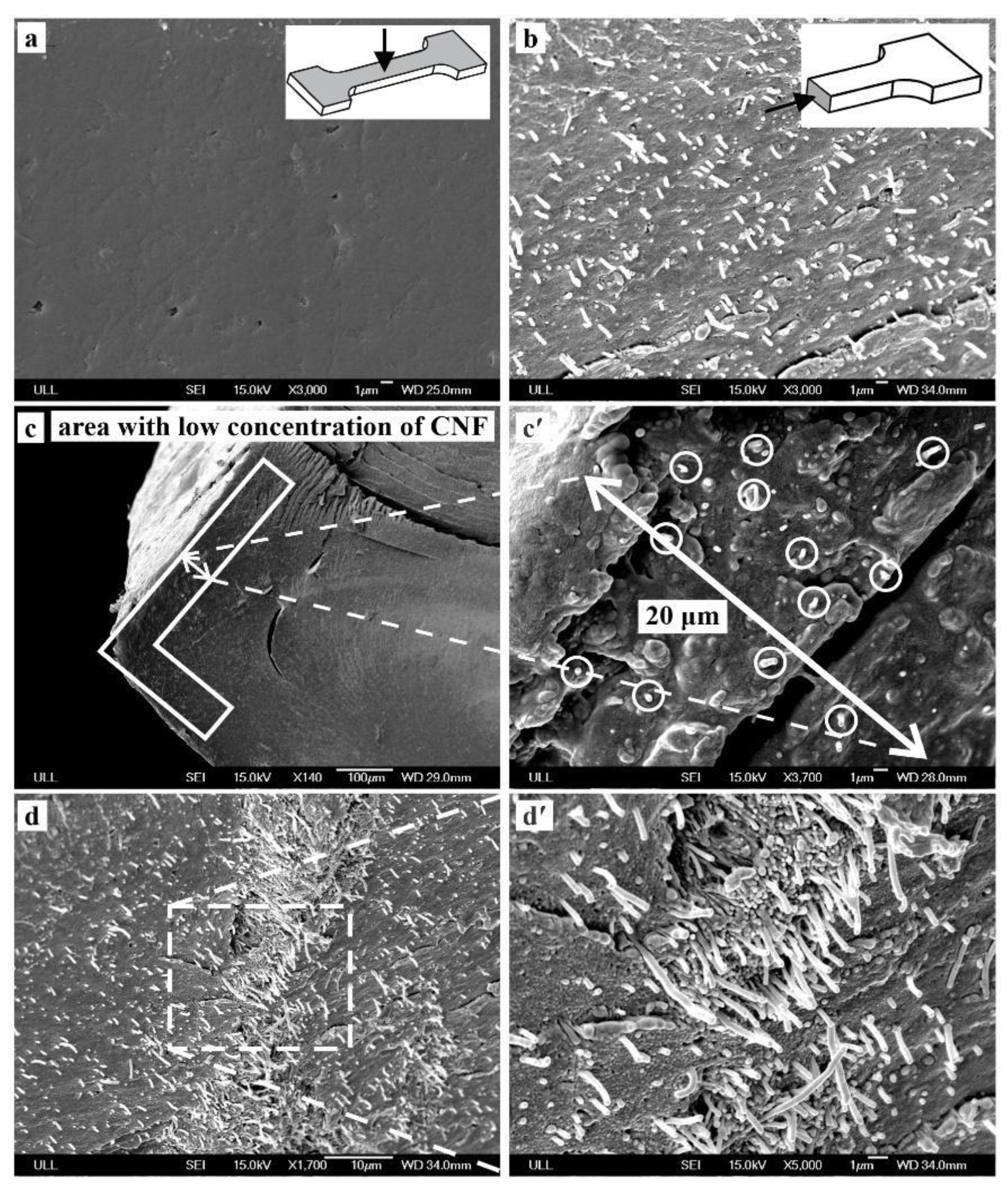
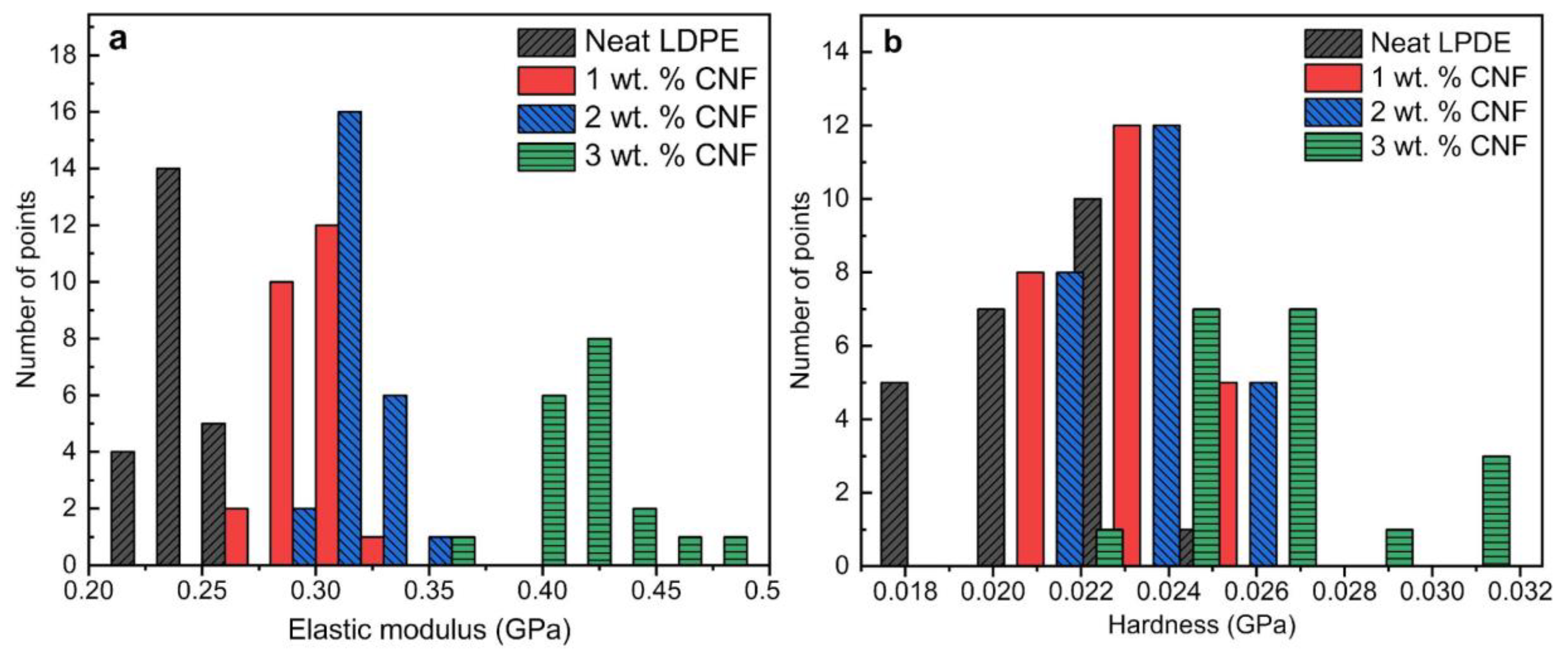
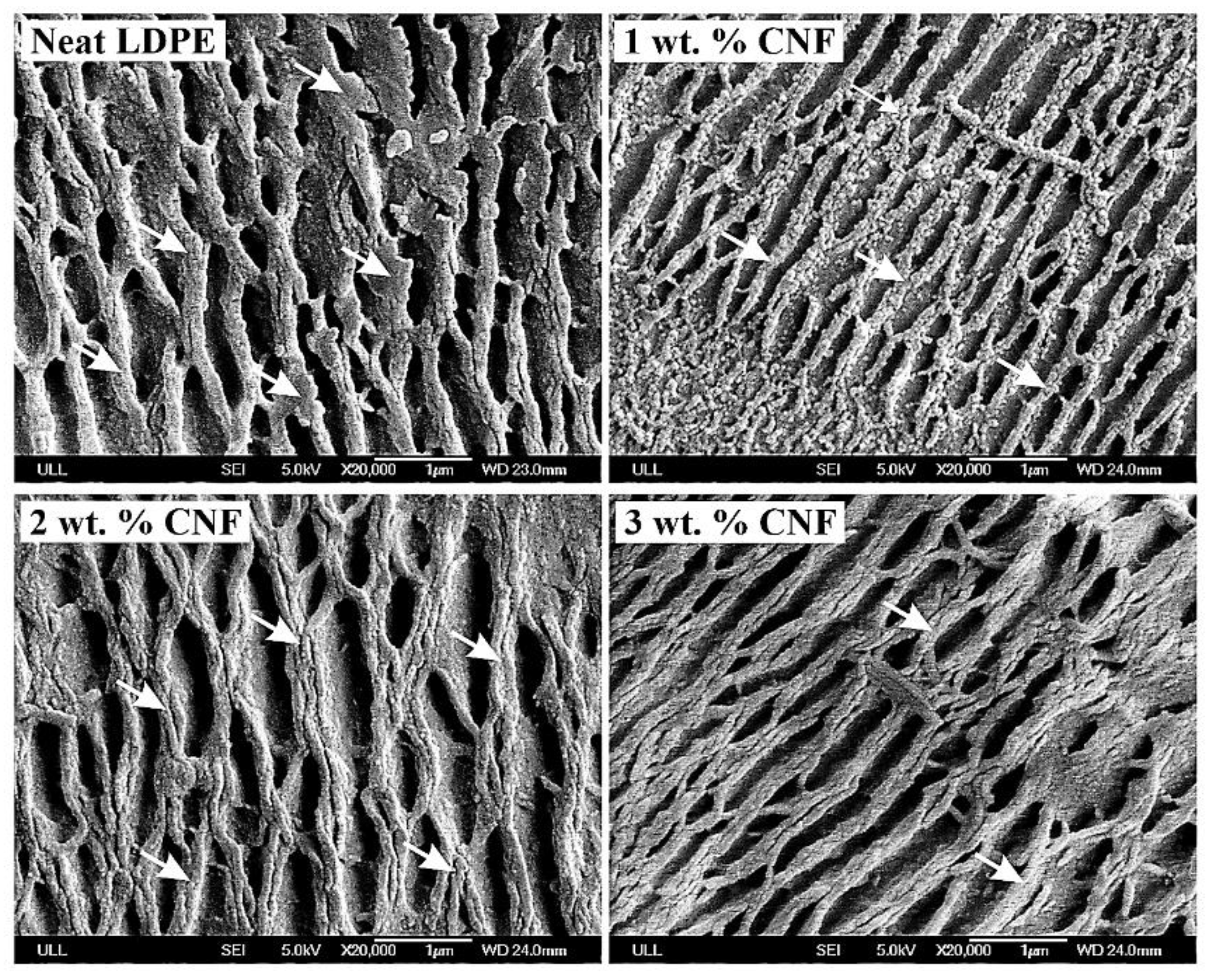
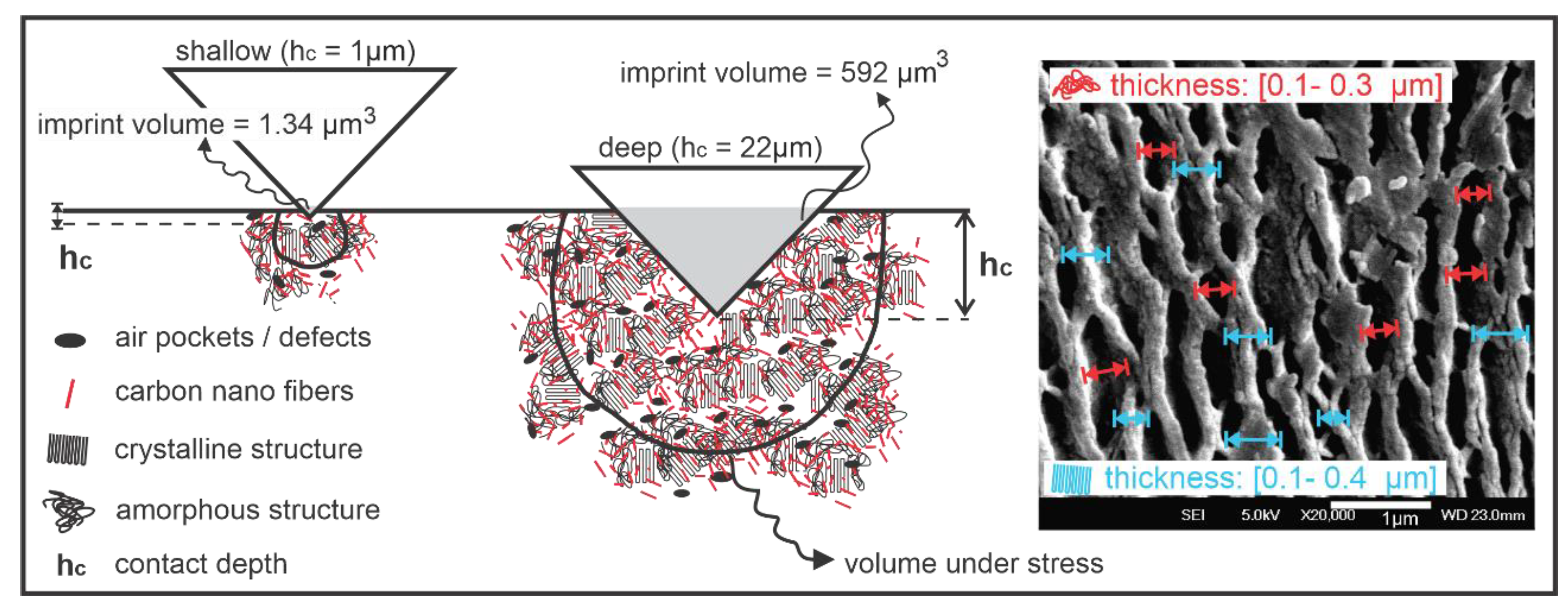
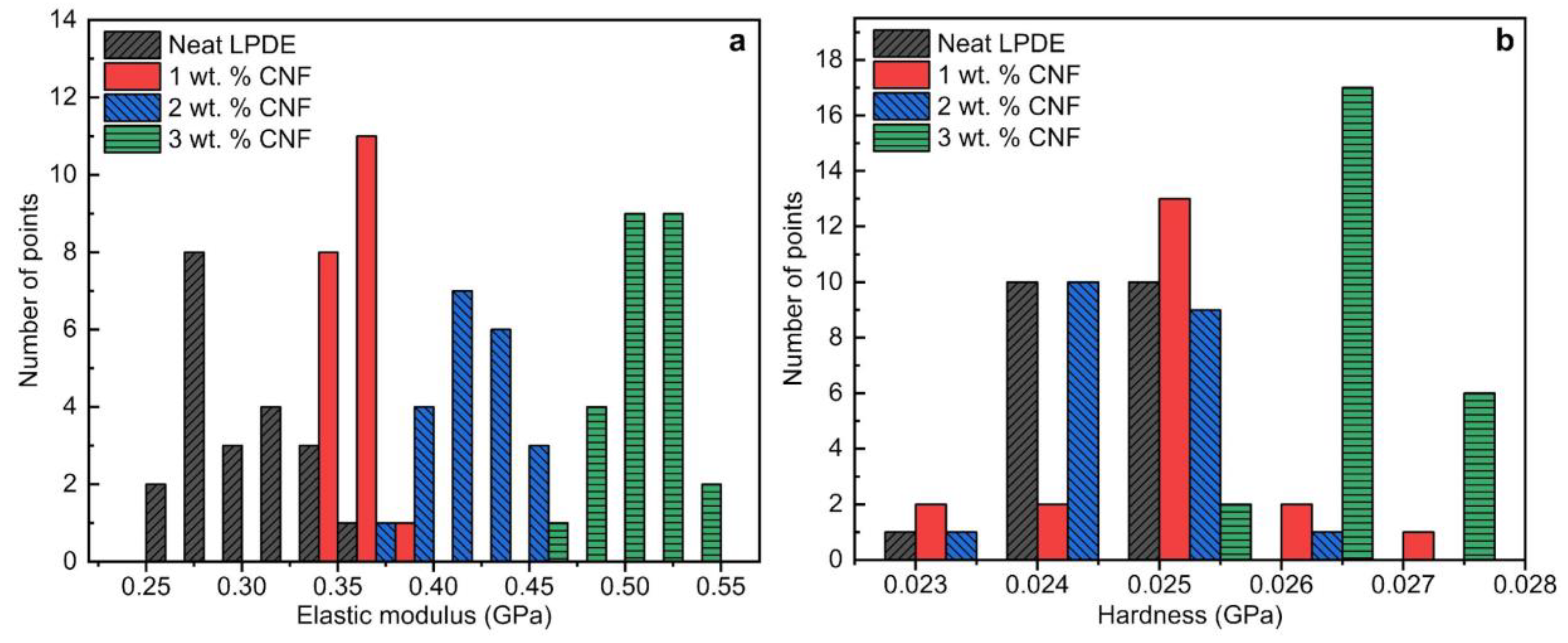
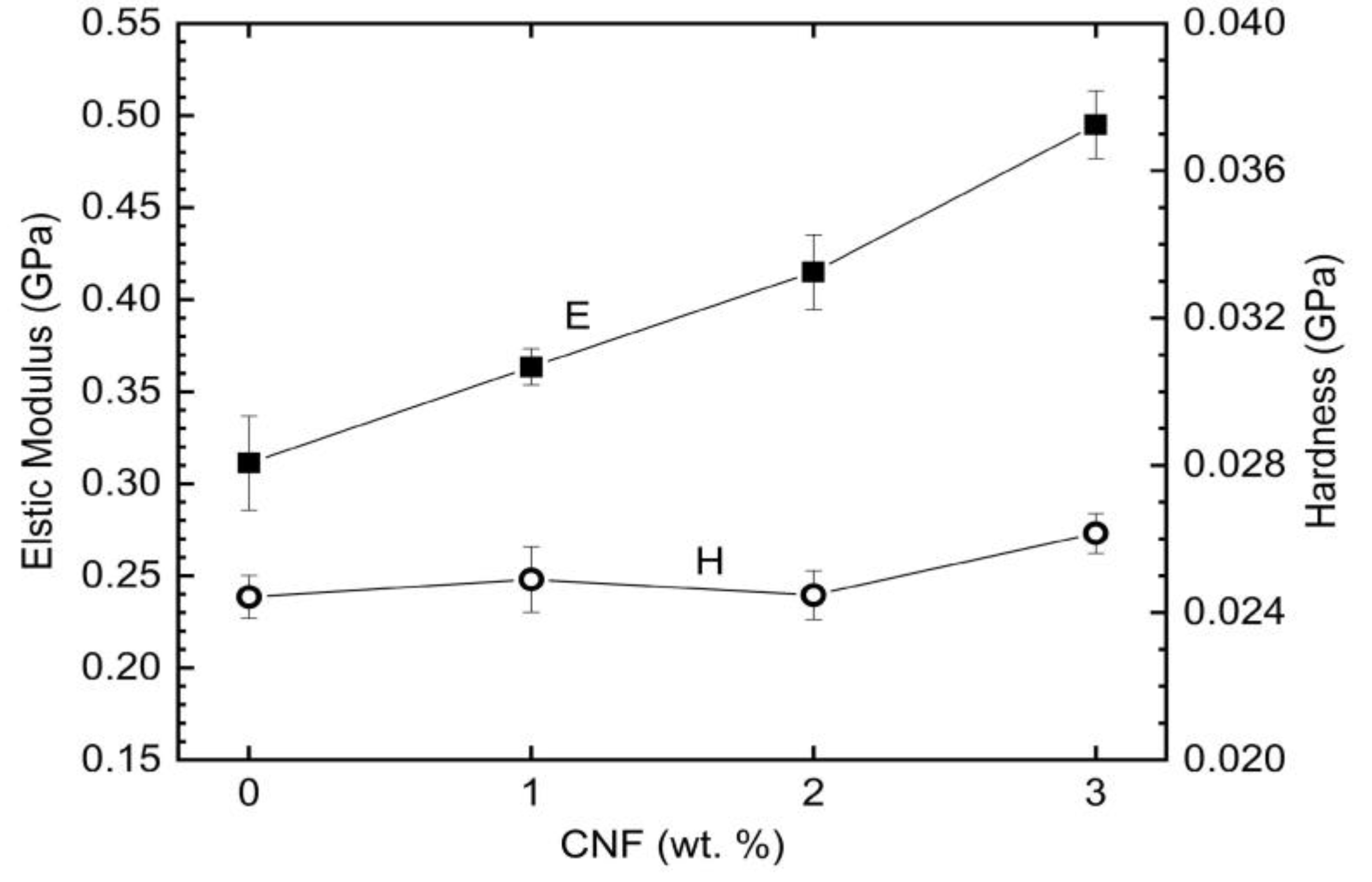
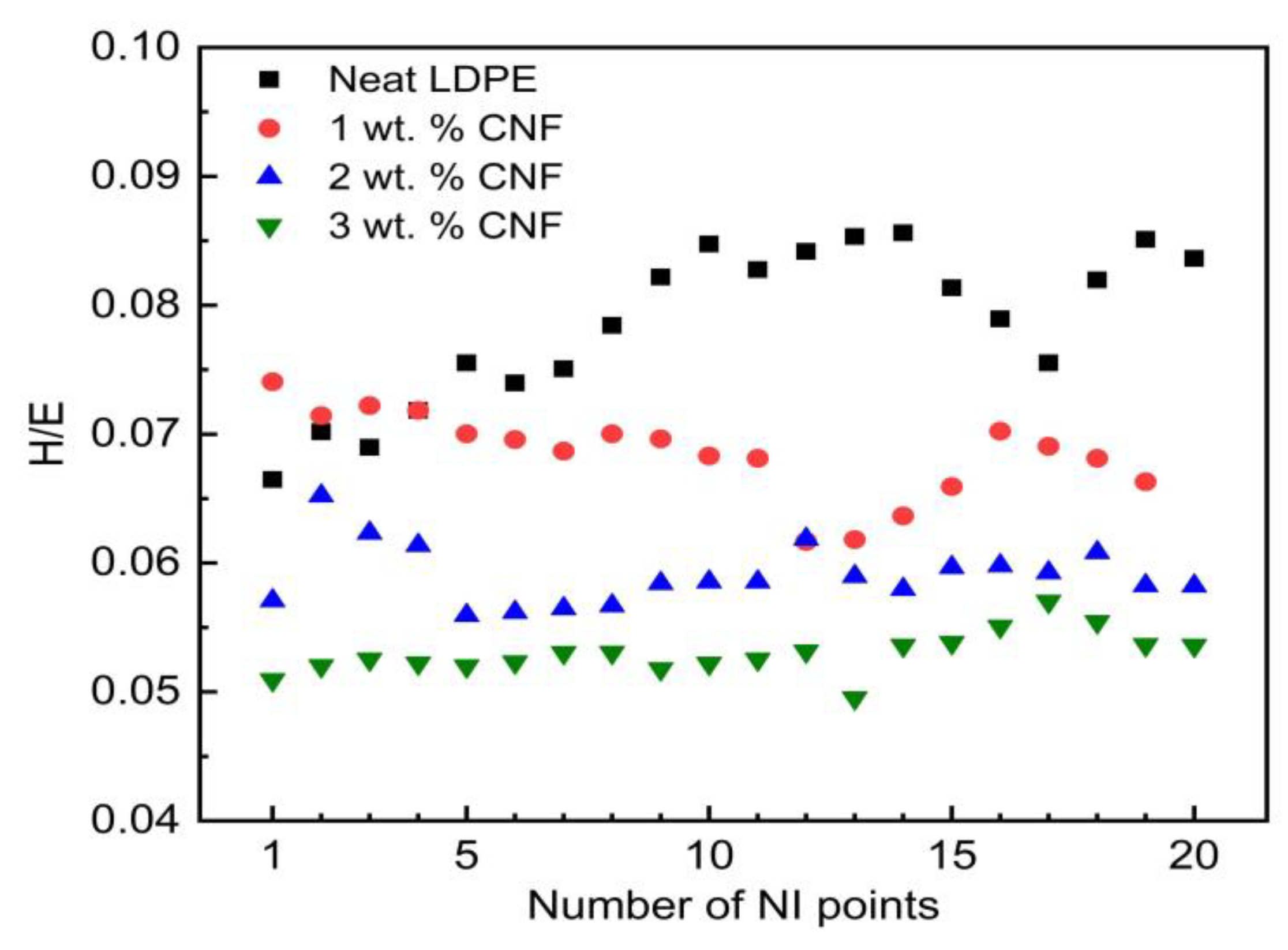
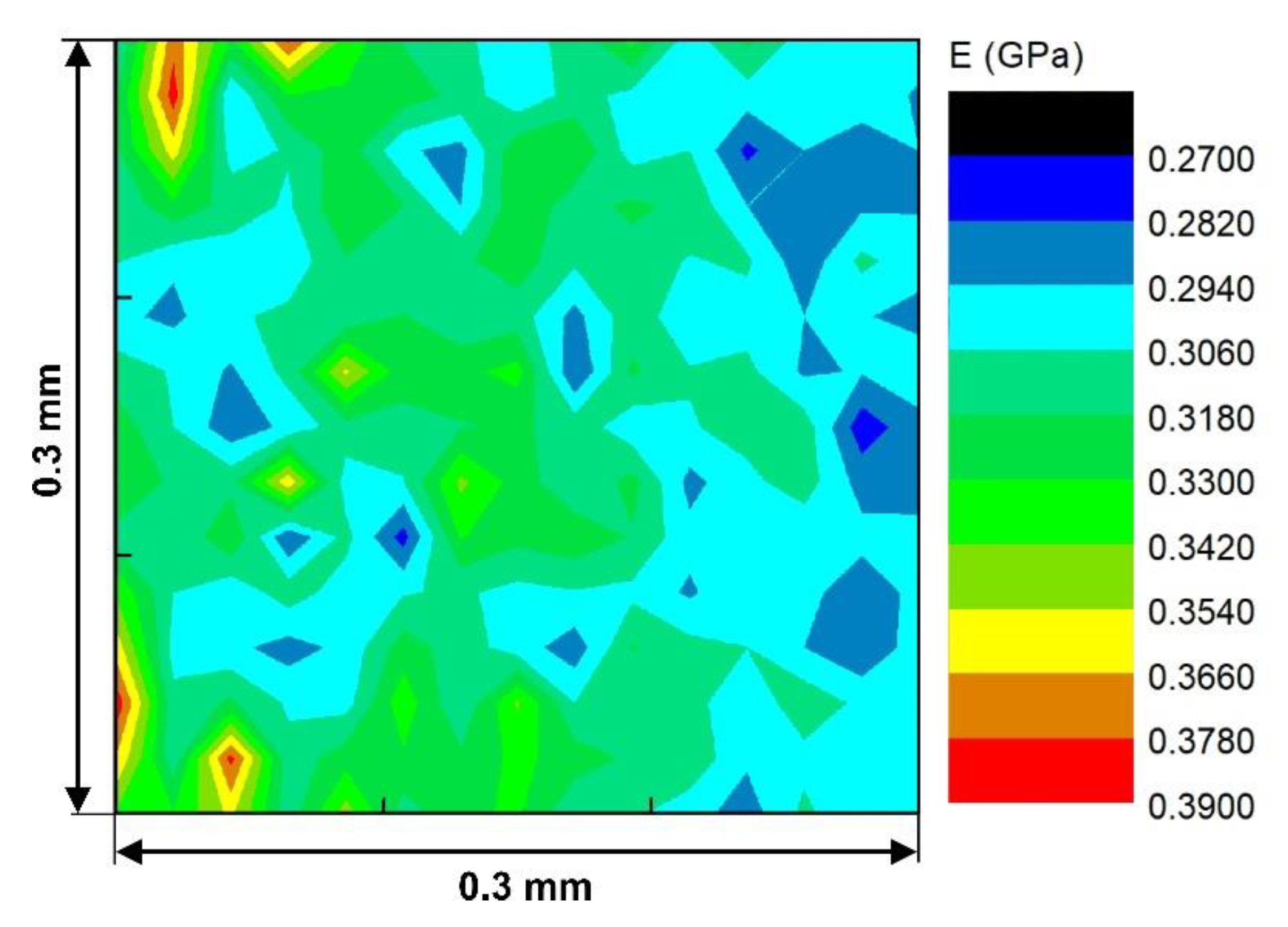
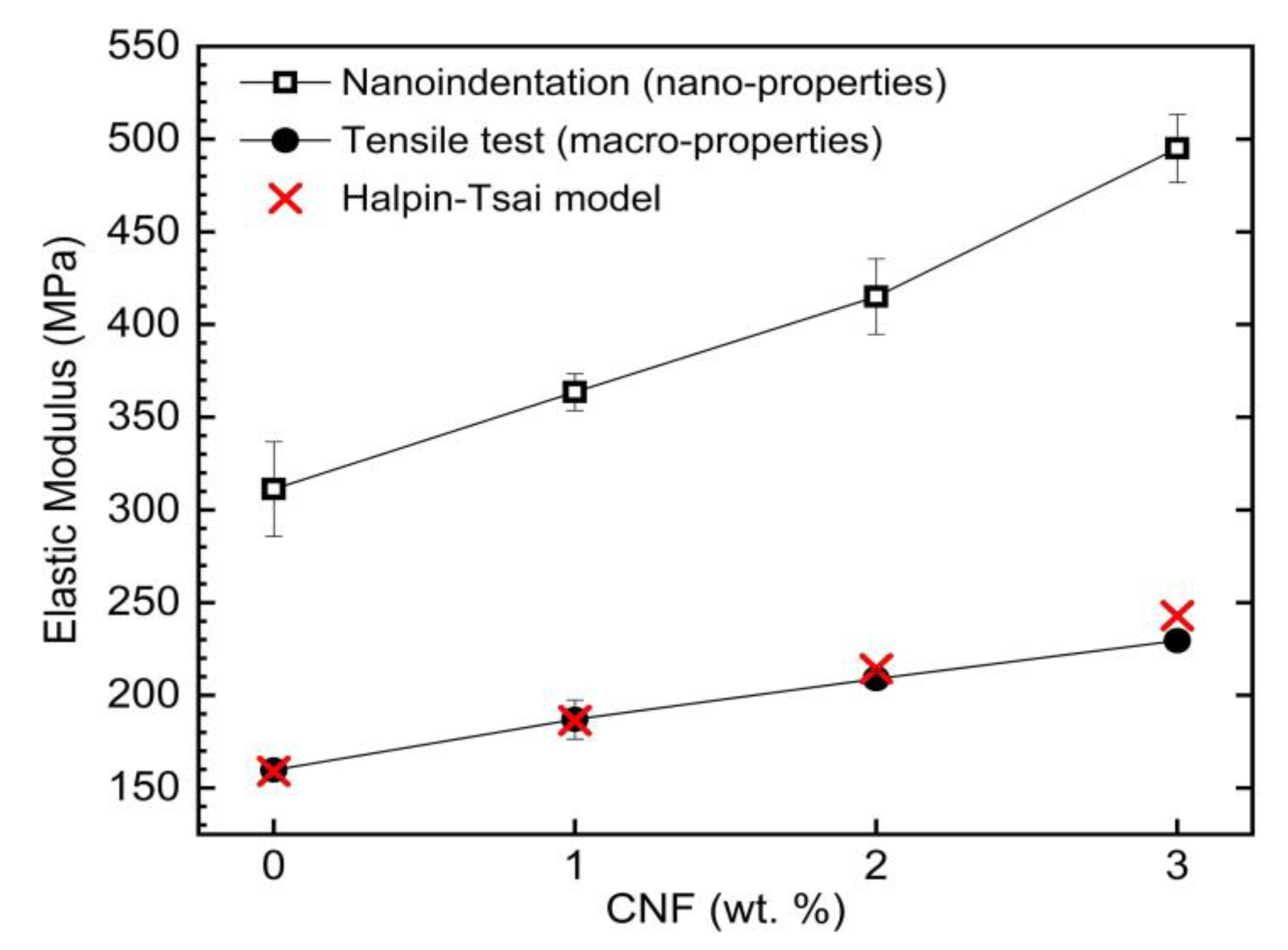
| Method A | Method B | Method C | |
|---|---|---|---|
| Image Z range | 608.4 nm | 464.2 nm | 125.7 nm |
| Image Rms | 65.7 nm | 38.7 nm | 18.72 nm |
| Image mean roughness () | 50.0 nm | 28.0 nm | 15.0 nm |
| Paper | Speed (rpm) | Time (minutes) | Lubricant |
|---|---|---|---|
| Method A | |||
| SiC–P200 | 180 | 5 | Water |
| SiC–P400 | 180 | 8 | Water |
| SiC–P800 | 180 | 8 | Water |
| SiC–P1200 | 180 | 10 | Water |
| SiC–P2500 | 180 | 10 | Water |
| Method B | |||
| SiC–P400 | 180 | 5 | Water |
| SiC–P600 | 180 | 8 | Water |
| SiC–P1200 | 180 | 8 | Water |
| SiC–P2500 | 180 | 8 | Water |
| Microcloth | 160 | 8 | Diamond suspension 1 μm size |
| Microcloth | 160 | 8 | Alumina suspension 0.05 μm size |
| Method C | |||
| SiC–P400 | 150 | 5 | Water |
| SiC–P800 | 150 | 8 | Water |
| SiC–P1200 | 150 | 8 | Water |
| SiC–P2500 | 180 | 8 | Water |
| Microcloth | 180 | 12 | Diamond suspension 1 μm size |
| Microcloth | 180 | 12 | Alumina suspension 0.3 μm size |
| Microcloth | 180 | 12 | Alumina suspension 0.05 μm size |
| CNF (wt. %) | ||||||||||||
|---|---|---|---|---|---|---|---|---|---|---|---|---|
| E | H | E | H | |||||||||
| Av. | Std. | cov% | Av. | Std. | cov% | Av. | Std. | cov% | Av. | Std. | cov% | |
| 0 | 0.25 | 0.01 | 5.17 | 0.022 | 0.002 | 8.001 | 0.31 | 0.03 | 8.22 | 0.024 | 0.001 | 2.387 |
| 1 | 0.30 | 0.02 | 5.04 | 0.023 | 0.001 | 4.809 | 0.36 | 0.01 | 2.73 | 0.025 | 0.001 | 3.570 |
| 2 | 0.32 | 0.03 | 8.49 | 0.023 | 0.001 | 5.872 | 0.42 | 0.02 | 4.90 | 0.024 | 0.001 | 2.710 |
| 3 | 0.42 | 0.05 | 10.76 | 0.025 | 0.002 | 9.319 | 0.50 | 0.02 | 3.72 | 0.026 | 0.001 | 2.074 |
© 2019 by the authors. Licensee MDPI, Basel, Switzerland. This article is an open access article distributed under the terms and conditions of the Creative Commons Attribution (CC BY) license (http://creativecommons.org/licenses/by/4.0/).
Share and Cite
Nikaeen, P.; Depan, D.; Khattab, A. Surface Mechanical Characterization of Carbon Nanofiber Reinforced Low-Density Polyethylene by Nanoindentation and Comparison with Bulk Properties. Nanomaterials 2019, 9, 1357. https://doi.org/10.3390/nano9101357
Nikaeen P, Depan D, Khattab A. Surface Mechanical Characterization of Carbon Nanofiber Reinforced Low-Density Polyethylene by Nanoindentation and Comparison with Bulk Properties. Nanomaterials. 2019; 9(10):1357. https://doi.org/10.3390/nano9101357
Chicago/Turabian StyleNikaeen, Peyman, Dilip Depan, and Ahmed Khattab. 2019. "Surface Mechanical Characterization of Carbon Nanofiber Reinforced Low-Density Polyethylene by Nanoindentation and Comparison with Bulk Properties" Nanomaterials 9, no. 10: 1357. https://doi.org/10.3390/nano9101357
APA StyleNikaeen, P., Depan, D., & Khattab, A. (2019). Surface Mechanical Characterization of Carbon Nanofiber Reinforced Low-Density Polyethylene by Nanoindentation and Comparison with Bulk Properties. Nanomaterials, 9(10), 1357. https://doi.org/10.3390/nano9101357







